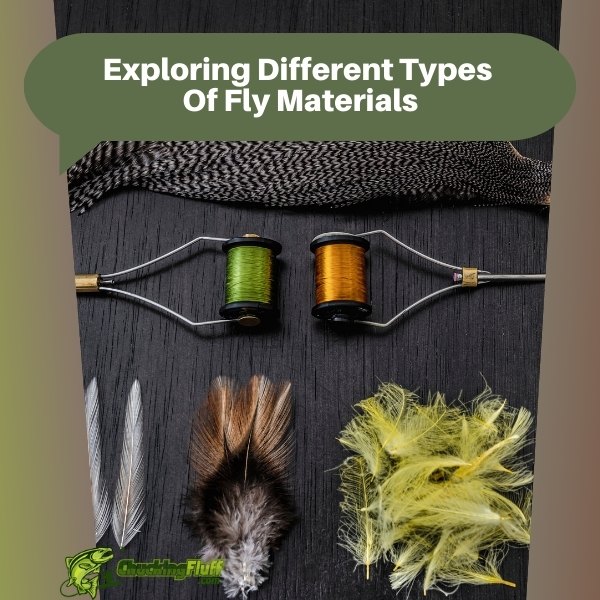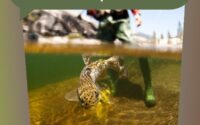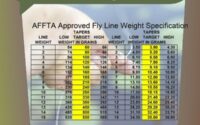| Disclosure: Just to be open and honest the buttons and links you click on in the website will in most cases take you to another website where you can purchase the products I am reviewing. As an Amazon Associate I earn from qualifying purchases. |
Exploring Different Types Of Fly Materials
Quick Post Navigation
Introduction
Fly tying is like crafting a masterpiece with feathers, fur, and fibers. Each material has a specific role in shaping the fly’s appearance, movement, and buoyancy. As an angler, you might think that catching fish is all about choosing the right spot and time, but what about the fly itself? That’s where fly tying materials come in—they’re the unsung heroes that can make or break your fishing experience.
In this article, we’ll delve into the world of fly materials, exploring the various types used by anglers to create flies that mimic insects, attract fish, and enhance your overall fly fishing success. Ready to get started? Let’s dive in!
Understanding Fly Tying Materials
Fly tying is more than just wrapping thread around a hook—it’s about choosing the right materials that match the type of fish you’re after, the water conditions, and even the season. Materials can be broadly categorized into natural and synthetic types, each offering unique benefits.
Natural materials, such as feathers and fur, have been used since the dawn of fly fishing and offer a traditional touch to your flies. On the other hand, synthetic materials have gained popularity for their durability, vibrant colors, and consistency.
Natural Fly Tying Materials
Natural materials like feathers, fur, and dubbing add lifelike movement and subtlety to your flies, making them look more natural to the fish. Let’s take a closer look at some of the most popular natural materials and their uses in fly tying.
Feathers
Feathers are a staple in fly tying, lending elegance and movement to your flies. Different feathers have specific roles, whether it’s adding buoyancy or simulating the legs and wings of insects.
Hackle Feathers
Hackle feathers, typically sourced from roosters, are used primarily in dry flies. Their stiff, barbed structure helps keep the fly afloat by creating surface tension. Ever wondered how a dry fly sits perfectly on the water? It’s all thanks to these feathers!
Marabou Feathers
Marabou, a soft, wispy feather from turkeys or chickens, is commonly used in streamers and wet flies. Its inherent fluidity in the water gives your fly an irresistible movement, perfect for mimicking baitfish or other aquatic creatures.
Fur
Fur adds a level of texture and realism to flies, often used to build up bodies or create legs and tails. Different types of fur serve different purposes in fly patterns.
Deer Hair
Deer hair is buoyant and versatile, making it an excellent choice for creating wings and bodies of dry flies like the famous Elk Hair Caddis. Its hollow structure helps these flies float effortlessly, even in fast-moving water.
Rabbit Fur
Rabbit fur is used in nymphs and leeches because of its soft, velvety texture. The fibers undulate naturally in the water, mimicking the movement of small aquatic creatures that fish love to prey on.
Dubbing
Dubbing refers to short fibers twisted onto thread, forming the body of a fly. It can be made from natural or synthetic fibers, and the choice often depends on the desired effect.
Natural Dubbing
Natural dubbing, such as squirrel or hare’s ear, adds a scruffy, natural look to flies. These fibers can trap air, giving a subtle sparkle underwater that entices fish.
Synthetic Dubbing
Synthetic dubbing, like Antron or SLF (Synthetic Living Fiber), offers brighter colors and easier handling. It’s ideal for those who want to create precise and uniform bodies without the inconsistency of natural fibers.
Synthetic Fly Tying Materials
Synthetic materials are becoming increasingly popular due to their durability, availability, and the vibrant colors they can bring to a fly. Let’s explore some of the most commonly used synthetic materials in modern fly tying.
Synthetic Fibers
Synthetic fibers can mimic everything from insect legs to fish scales, offering endless creative possibilities.
Antron
Antron is a synthetic yarn-like material known for its translucency and subtle sparkle. It’s often used in nymphs, wet flies, and emergers to add a touch of flash without overwhelming the fly’s natural look.
Flashabou and Tinsel
Want to catch a fish’s eye? Add some Flashabou or tinsel to your fly. These materials create a metallic shine, simulating the scales of baitfish and drawing attention to your fly in murky or deep waters.
Foam and Rubber Materials
Foam and rubber materials are the go-to for buoyant flies or those designed to mimic insects with a bouncy, lifelike action.
Closed-Cell Foam
Closed-cell foam is the secret behind poppers, hoppers, and other floating flies. Its light and buoyant nature keeps flies above the water’s surface, making them ideal for targeting surface-feeding fish.
Rubber Legs
Rubber legs add a dynamic movement to flies, whether it’s a hopper or a stonefly nymph. The wiggling action of these legs makes your fly look alive, convincing even the wariest fish to take a bite.
Beads, Eyes, and Weighting Materials
Weighting materials help you control the depth and action of your fly, making them an essential part of any fly tier’s arsenal.
Beads
Beads, typically made of brass, tungsten, or plastic, add weight and a bit of shimmer to your fly. Tungsten beads, being denser, are great for getting flies down quickly in fast-moving currents.
Lead-Free Wire
Lead-free wire is an environmentally friendly option for adding weight to your flies. It’s easy to wrap around the hook shank and helps you get your fly to the desired depth.
Dumbbell Eyes
Dumbbell eyes are commonly used in streamers to give them a “jigging” motion as they are stripped through the water. These eyes add weight and make the fly swim with a head-down action, mimicking injured or fleeing baitfish.
Choosing the Right Material for Your Fly
Choosing the right material is crucial for achieving the desired look and action of your fly. When selecting materials, consider the following factors:
- Water Type: Clear or murky water can determine whether you use bright or muted colors.
- Fly Type: Dry flies require buoyant materials like hackle feathers, while nymphs benefit from denser materials.
- Target Species: Trout might be attracted to subtle, natural patterns, whereas bass could go for flashier, vibrant flies.
By understanding these factors, you can craft flies that not only look good but also perform well in different fishing conditions.
Common Fly Patterns and Their Materials
Let’s look at some classic fly patterns and the materials needed to tie them.
Woolly Bugger
The Woolly Bugger is a versatile streamer that can mimic leeches, minnows, or other prey.
- Body: Chenille or dubbing.
- Tail: Marabou feather.
- Hackle: Saddle hackle.
Elk Hair Caddis
This dry fly is a go-to pattern for imitating adult caddisflies.
- Body: Dubbing (natural or synthetic).
- Wing: Elk hair.
- Hackle: Brown or grizzly hackle.
Zebra Midge
The Zebra Midge is a simple yet effective fly, especially for targeting trout.
- Body: Thread or fine wire.
- Ribbing: Fine silver or gold wire.
- Head: Bead.
Innovations in Fly Tying Materials
Fly tying is constantly evolving, with new materials being introduced to create more realistic and durable flies. Recent innovations include UV-reactive materials, microfibers, and even biodegradable options. These materials not only improve fly performance but also reduce the environmental impact of fly fishing.
Conclusion
Choosing the right fly materials is both an art and a science. Understanding the characteristics of natural and synthetic materials can make a world of difference in your fly tying and fishing success. Whether you’re tying traditional dry flies or experimenting with synthetic streamers, having a solid grasp of the materials at your disposal will help you create flies that look good, move well, and, most importantly, catch fish.
FAQs
1. What is the best material for dry flies? The best materials for dry flies are buoyant ones like hackle feathers and deer hair, which help keep the fly afloat and maintain its shape.
2. Why use synthetic materials in fly tying? Synthetic materials offer consistency, durability, and vibrant colors that can be difficult to achieve with natural materials, making them ideal for certain fly patterns.
3. How do I choose between natural and synthetic dubbing? Choose natural dubbing for a more traditional, scruffy look and synthetic dubbing for brighter, consistent bodies and easier handling.
4. What are the most popular synthetic fly tying materials? Some popular synthetic materials include Antron, Flashabou, and closed-cell foam, all of which add unique properties to flies.
5. How do weighted materials impact fly performance? Weighted materials like beads and wire help flies sink to the desired depth and create specific actions, such as jigging or fluttering, to attract fish.



